
Hoverflies, also called flower flies or syrphids, make up the insect family Syrphidae. As their common name suggests, they are often seen hovering or nectaring at flowers; the adults of many species feed mainly on nectar and pollen, while the larvae (maggots) eat a wide range of foods. In some species, the larvae are saprotrophs, eating decaying plant and animal matter in the soil or in ponds and streams. In other species, the larvae are insectivores and prey on aphids, thrips, and other plant-sucking insects.

Syrphus ribesii is a very common Holarctic species of hoverfly. Its larvae feed on aphids. In common with many other species of hoverfly, males have the eyes meeting on the top of the head, whilst females have their eyes widely separated.

Platycheirus clypeatus is a species of hoverfly. It is found across the Palearctic and in the Nearctic. The larvae feed on aphids. Adults are usually found on the edges of woodland or scrub, heath or along hedgerows where they visit a wide range of flowers.
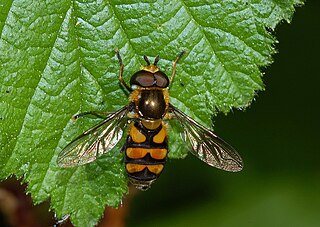
Didea fasciata is a Holarctic species of hoverfly.

Leucozona lucorum is a Palearctic and Nearctic species of hoverfly.

Parasyrphus is a genus of hover fly found in the holarctic area of the world including species like Parasyrphus tarsatus located in some very northern areas. Very few of the 31 identified species have known larvae. Of the known larvae most are predators of tree aphids with one, Parasyrphus nigritarsis, that feed on beetle eggs and larvae.
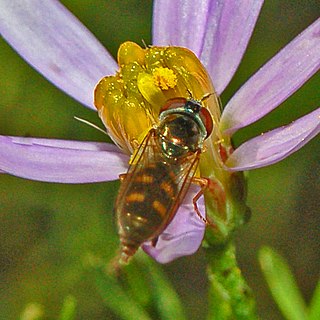
Platycheirus scutatus is a very common species of hoverfly. It is a Holarctic species.
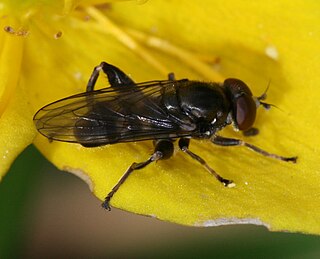
Chalcosyrphus (Xylotomima) nemorum , the Dusky-banded Leafwalker, is a common species of syrphid fly with a Palearctic and Nearctic distribution. Hoverflies get their names from the ability to remain nearly motionless while in flight. The adults are also known as flower flies for they are commonly found around and on flowers, from which they get both energy-giving nectar and protein-rich pollen. Larvae have been found under the bark of Larix, Pinus and a variety of hardwoods.

Syrphus torvus, the Hairy-eyed Flower Fly, is a common species of hoverfly found in the Holarctic. The adults feed on pollen and nectar, but the larvae feed on aphids.

Syrphus vitripennis is a very common European and North American species of hoverfly. Its larvae feed on aphids

Epistrophe grossulariae is a Holarctic species of hoverfly.

Platycheirus ambiguus is a small widespread species of hoverfly found across the Palearctic from Ireland to Japan. A spring species found in flight in April and May, it visits spring-flowering trees and shrubs, e.g., Prunus spinosa in deciduous woodland and scrub.
Platycheirus amplus is a Holarctic species of hoverfly found in wetlands, fens, moorland streams and bogs.

Platycheirus angustatus is a species of hoverfly. It is found in many parts of the Palearctic, and in the Nearctic.

Meligramma guttatum is a Holarctic species of hoverfly.

Megasyrphus erraticus is a Holarctic species of hoverfly associated with mature conifer woodlands and plantations.
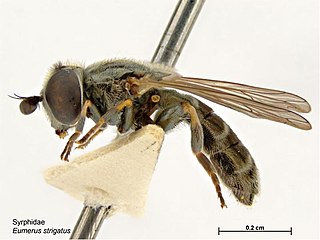
Eumerus strigatus, the onion bulb fly, is a fairly common species of syrphid fly observed across Europe. Also found in north-central North America and other scattered locations as an introduced species from infested bulbs. Syrphid flies are also known as hover flies or flower flies because the adults are frequently found hovering around flowers from which they feed on nectar and pollen. The larvae feed on various bulbs.
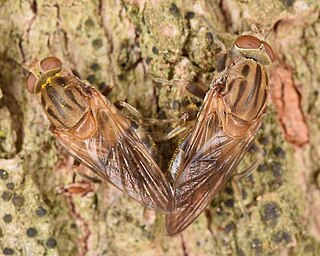
Brachyopa vacua , the Yellow-spotted Sapeater, is a rare, species of syrphid fly. It has been observed in Canada, Alaska and northern United States. Hoverflies get their names from the ability to remain nearly motionless while in flight. The adults are also known as flower flies for they are commonly found around and on flowers from which they get both energy-giving nectar and protein-rich pollen. Larvae for this genus are of the rat-tailed type. B.vacua larvae were collected from the juice of decaying fungi under dead bark.
Hammerschmidtia ferruginea , the Aspen hover fly, is a rare, species of syrphid fly. It has been observed in Canada, Alaska and the northern United States. Hoverflies get their names from the ability to remain nearly motionless while in flight. The adults are also known as flower flies for they are commonly found around and on flowers, from which they get both energy-giving nectar and protein-rich pollen. Larvae for this genus are of the rat-tailed type. Hammerschmidtia ferruginea larvae have been described by Rotheray.
Platycheirus normae, the paddlearm sedgesitter, is a rare species of syrphid fly observed in northeastern North America. Hoverflies can remain nearly motionless in flight. The adults are also known as flower flies for they are commonly found on flowers, from which they get both energy-giving nectar and protein-rich pollen. Larvae are aphid predators.


















